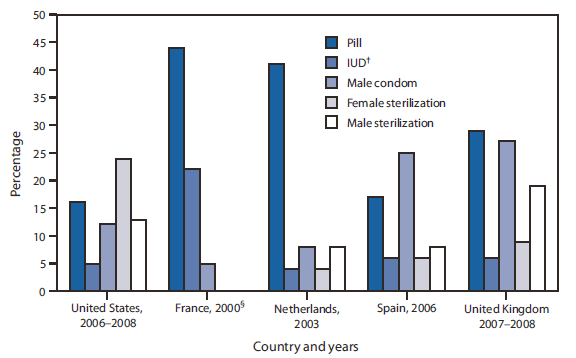Persons using assistive technology might not be able to fully access information in this file. For assistance, please send e-mail to: mmwrq@cdc.gov. Type 508 Accommodation and the title of the report in the subject line of e-mail.
QuickStats: Use of Selected Contraceptive Methods by Married Women of Childbearing Age in the United States, 2006--2008, Compared with Married Women in Selected Countries with Low Fertility Rates,* 2000--2008

Among countries with low fertility (total fertility rates of ≤2.1), a higher percentage of married women of childbearing age in the United States rely on female sterilization (24%) as their method of contraception, compared with women in other countries (range: 4%--9%). Women in France, the Netherlands, and the United Kingdom are more likely to rely on oral contraception (29%--44%) than women in the United States (16%). Women in France use the IUD (22%) to a greater extent than women in the United States (5%), whereas the male condom is used by partners of approximately 25% of married women in Spain and the United Kingdom, nearly twice the percentage found in the United States.
Source: Mosher WD, Jones J. Use of contraception in the United States: 1982--2008. Vital Health Stat 2010;23(29). Available at http://www.cdc.gov/nchs/data/series/sr_23/sr23_029.pdf.
Alternate Text: The figure above shows the use of selected contraceptive methods by married women of childbearing age in the United States, 2006-2008, compared with married women in selected countries with low fertility rates from 2000-2008. Among countries with low fertility (total fertility rates of ≤2.1), a higher percentage of married women of childbearing age in the United States rely on female sterilization (24%) as their method of contraception, compared with women in other countries (range: 4%-9%). Women in France, the Netherlands, and the United Kingdom are more likely to rely on oral contraception (29%-44%) than women in the United States (16%). Women in France use the IUD (22%) to a greater extent than women in the United States (5%), whereas the male condom is used by partners of approximately 25% of married women in Spain and the United Kingdom, nearly twice the percentage found in the United States.
Use of trade names and commercial sources is for identification only and does not imply endorsement by the U.S. Department of
Health and Human Services.
References to non-CDC sites on the Internet are
provided as a service to MMWR readers and do not constitute or imply
endorsement of these organizations or their programs by CDC or the U.S.
Department of Health and Human Services. CDC is not responsible for the content
of pages found at these sites. URL addresses listed in MMWR were current as of
the date of publication.
All MMWR HTML versions of articles are electronic conversions from typeset documents.
This conversion might result in character translation or format errors in the HTML version.
Users are referred to the electronic PDF version (http://www.cdc.gov/mmwr)
and/or the original MMWR paper copy for printable versions of official text, figures, and tables.
An original paper copy of this issue can be obtained from the Superintendent of Documents, U.S.
Government Printing Office (GPO), Washington, DC 20402-9371;
telephone: (202) 512-1800. Contact GPO for current prices.
**Questions or messages regarding errors in formatting should be addressed to
mmwrq@cdc.gov.
 ShareCompartir
ShareCompartir



